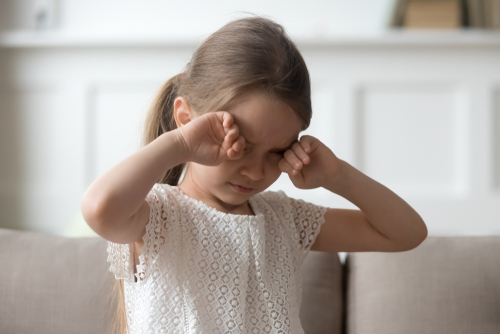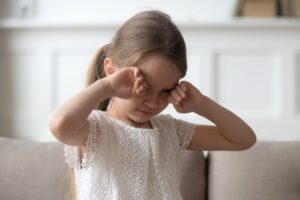Blog post by: Eye Physicians of Long Beach

Did you know that it takes up to two years for your child’s eyes to develop fully? If your child’s eyes aren’t developing as they should, they may experience vision problems that can impact learning and quality of life.
If left untreated, some eye conditions can be irreversible later on in life. That’s why it’s crucial to schedule routine eye exams with a pediatric ophthalmologist.
Pediatric ophthalmology focuses on children’s eye health and treating eye conditions that affect children. Keep reading to learn about what makes pediatric ophthalmology so important to the health of your child!
Benefits of Pediatric Ophthalmology
Is there a correct age to take your child in for an eye exam? Most pediatric ophthalmologists recommend eye exams for children starting at six months old. By starting this early, your child’s eye doctor can detect any vision disorder promptly before it can affect your child’s vision.
Having healthy eyes also plays a key role in child development. For instance, an undiagnosed problem with their eyes can impact everything from socializing to how your child learns.

Eye examinations also ensure your child has no visual problems that could affect their safety. The earlier a vision problem is diagnosed by an eye doctor and corrected, the faster your child can realize their full potential without struggling with any vision difficulties to hold them back.
Identifying eye diseases sooner will not only save your child’s vision but also protect them from other serious health issues. For example, some types of cancers, although uncommon, can also be identified during eye exams.
Dr. Manchandia has over 10 years of training and experience in evaluating examining and treating your child. He will spend time thoroughly examining, diagnosing, treating, and addressing any pediatric eye concerns you may have.
How to Prepare for Your Child’s Eye Exam
Before going to the eye doctor, take the time to put together a list of questions you can ask. Asking direct questions will allow you to better understand your child’s vision system and condition if any. Here are some helpful questions to ask:
- What is the name of my child’s vision problem?
- When should we make another appointment?
- Is there anything to watch out for in-between appointments?
- Should I call when I see something unusual?
- Will the strength of my child’s prescription continue to increase?
- Will eyeglasses, like medicine, make my child’s eyes better?
- Is there any vision therapy that may help my child?
Our technicians and staff have extensive experience seeing kids and will make it a very relaxing experience for your child. They are fully trained in using our state-of-the-art pediatric-specific eye equipment to evaluate and diagnose your child.
FAQs About Pediatric Vision Care
Below are some of the most frequently asked questions that pediatric ophthalmologists get regarding children’s vision.
What are the Signs of Vision Problems in Children?
Usually, children can’t tell if they have eye issues, making it even more important to look for red flags. Some of the warning signs of vision problems include:

- Increased sensitivity to light
- Persistently red eyes
- A cloudy iris
- Eyes that appear crossed
- Tilting the head at an odd angle to look at things
- White spots on the pupil
- Excessive blinking or tearing
- Weak focus in one eye
- Drooping eyelids
- Constantly rubbing the eyes
- One eye appears lazy
- Your baby can’t seem to notice you across the room
- Discharge around or in the eyes
- Moving objects very close to the eyes to see them
Dr. Manchandia has extensive years of experience treating these and other conditions. He can also address if your child has failed a vision screening or needs glasses. Dr. Manchandia has years of experience in pediatric cataract surgery, strabismus surgery, ptosis surgery, blocked tear ducts surgery, to name a few.
How Can I Keep My Child’s Glasses On?
It can sometimes be quite difficult to convince your child to do anything. The best way to make your child wear their glasses is to set them back on their face whenever they remove them.
After doing this, immediately distract them, which may be easiest to do by handing them their favorite toy. Remain positive and patient throughout and put the glasses back on again if they continue to take them off.
Will My Child Need Glasses for the Rest of Their Life?
Most children outgrow the need for glasses. Many vision conditions in children are due to changes in the shape of the eye.
As your child grows and gets older, the shape of the eye stabilizes. The time it will take to stop depending on glasses will be based on the severity of the eye problem, among other factors.
How and When Should My Child Wear Glasses?
Your child should wear their glasses whenever they’re awake unless advised otherwise. However, they should put their glasses aside during intense play or swimming to prevent damaging the glasses.
You can buy goggles to provide eye protection while swimming.

Our opticians at Eye Physicians of Long Beach have over 30 years of experience fitting children with eyeglasses. We carry a wide assortment of children’s frames, contact lenses, eye patches, and goggles.
What are Common Vision Problems in Children?
For children, some of the most common vision problems are refractive problems. These include nearsightedness, farsightedness, and astigmatism. Children may suffer from these and other visual problems like:
Astigmatism
Astigmatism is a refractive error that’s caused by having an irregularly shaped cornea. When the cornea is an irregular shape, it prevents light from reaching the retina, resulting in distorted or blurred vision at all distances.
Astigmatism can cause headaches and eye strain.
Farsightedness
When it comes to farsightedness, your child will have no problem noticing distant objects, but they will have difficulty reading or seeing anything that’s up close. Farsightedness is due to the eye being too short for the focusing power of the eye.
Nearsightedness
Nearsightedness makes it easy for a child to see up-close objects. However, they will struggle to see things that are further away.
Nearsightedness occurs when the eye is too long, preventing your child’s eyes from focusing light on the retina, resulting in blurry distant vision.

Amblyopia
Even if your child’s eyes don’t have any structural problems, there can still be distorted images sent to the brain. This condition is referred to as a lazy eye or amblyopia.
Untreated, a lazy eye can lead to permanent vision loss. Amblyopia is a leading cause of vision loss in children.
Strabismus
Strabismus is also known as crossed eyes. When your child has strabismus, one eye can focus, but the other turns up or down, outward or inward.
If your child needs to turn their head to look at you or has one eye that can’t look straight ahead, they may have strabismus.
Cataracts
Although cataracts are typically age-related, they can also affect infants and children. Infants start looking around and tracking things with their eyes at about 3 to 4 months old.
If you notice your baby isn’t responding, it might be an indication of cataracts. It’s also possible to see a grayish or white area on your child’s eye, which is another sign of cataracts. Children can also develop cataracts at a young age, which could occur in either one or both eyes.
Ptosis
Droopy eyelid, also called ptosis, occurs when the muscle that elevates the eyelid is weak. The most common cause in children is poor development of this muscle. This is often present at birth and is called congenital ptosis.
If the ptosis is mild and does not interfere with visual development, it does not require any treatment. However, an eye exam by a pediatric ophthalmologist is recommended to evaluate if the ptosis interferes with vision and if treatment is warranted.
Blocked Tear Duct
Tears are drained by two small holes in the inner corners of our eyes and flow down a tube into the nose. Tear duct obstruction in children commonly occurs at or near the time of birth and is caused by the failure of a membrane within this tube to open normally. If the tear duct is blocked, there will be a backflow of tears which can lead to crusting and discharge from the eye, especially when the child wakes up.
A pediatric ophthalmologist can perform certain tests in the office to confirm the diagnosis. It is important that the eyes be examined to look for other causes of tearing in a child such as allergies or even childhood glaucoma.
Give Your Child the Gift of Healthy Eyes

Children of all ages require highly specialized eye care. That’s why Dr. Ajay Manchandia, the pediatric ophthalmologist at Eye Physicians of Long Beach utilizes cutting-edge technology and child-modified equipment to perform thorough eye exams, diagnose and treat any vision and eye issues for children.
Dr. Ajay Manchandia, MD, MS, is a board-certified pediatric ophthalmologist. He’s also a member of the American Association of Pediatric Ophthalmology and Strabismus. Dr. Manchandia is compassionate, patient, and an expert at meeting all of your child’s eye needs.
Are you looking for a pediatric ophthalmologist? Schedule an appointment at Eye Physicians of Long Beach in Long Beach, CA, now!
